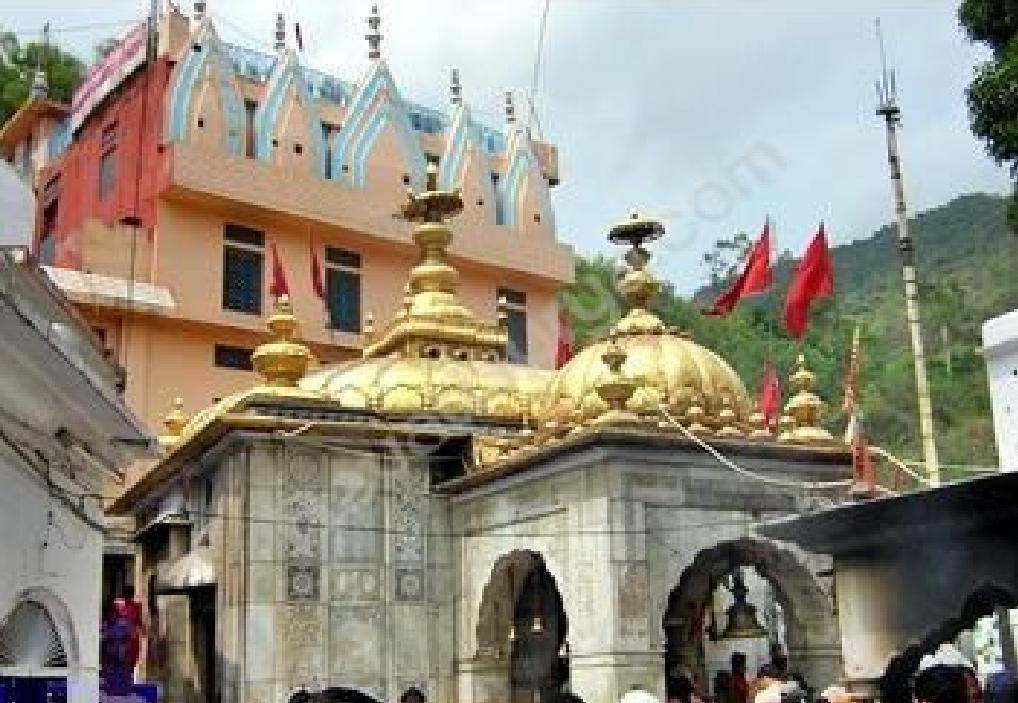Sri Jawala Ji Shakthi Peeth Temple, Himachal Pradesh

Address
Sri Jawala Ji Temple, Kohala, Jawalamukhi, Himachal Pradesh – 176031. Phone Number: 01970 222 223
Diety
Shakti: Siddhida (Ambika) Bhairava: UnmattaBhairav Body part or ornament: Tongue
Introduction
Jwalamukhi Temple / Flaming Goddess / Jwala Devi Temple in Himachal Pradesh is one amongst the AshtadasaShaktipeethas and is considered extremely sacred for the Hindus. Jwalamukhi Temple, dedicated to Goddess Jwalamukhi, is situated 30 km south of Kangra valley in Himachal Pradesh. The unique feature of the temple is there is no idol to worship, natural flames in the temple that burn continuously without any fuel and are seen breaking out from a rock-side without any external assistance. These flames are worshipped as a manifestation of the nine Goddesses – Mahakali, Maha Lakshmi, Saraswati, Unpurna, Chandi, Hinglaj, BindhyaBasni, Ambika, Siddhida and Anji Devi. The beautiful temple is set against a cliff. The dome of temple is aureate is of gold and has pinnacles. It also has a picturesque folding doorway of silver plate which was gifted by Sikh Raja Kharak Singh. The temple has an Indo-Sikh feel to it.
Puranic Significance
Jwalamukhi refers to the deity with flaming mouth. As per the legends, the Tongue of Sati fell here at the time of self-sacrifice. Ever since, the Goddess occupied the place and she manifested in nine flames. After years, one day Raja Bhumi Chand Katoch, a resident of Kangra and a great devotee of Goddess Durga, dreamt of the holy place. ANOTHER STORY OF SATI: In Hindu mythology, the son of Brahma, King Prajapati Daksha had a daughter named Sati. Princess Sati grew up adoring the legends and tales of Shiva, and when finally her age of getting married came, she knew it was only the ascetic Lord Shiva of Kailash where her heart and soul resided. Soon enough, Daksha’s daughter left her father’s luxuries and palace and began her meditation to win Shiva’s heart. She performed intense penance in dense forests and renounced food completely. When she finally pleased Shiva through her austerities, the lord of Kailash appeared in front of her and agreed to marry her. The legend goes that Sati and Shiva were happy in their marital bliss, but their marriage had not gone down too well with King Daksha, who considered ascetic Shiva nothing short of an uncouth lad who lives a hermit’s life not worthy of his daughter. So when Daksha organized a great yajna, he invited all the deities, gods and sages–but consciously excluded his son-in-law Shiva to insult him. Hurt by her father’s decision, Sati decided to visit her father and demand the reason for not inviting them. When she entered Daksha’s palace, she was bombarded with insults directed towards the Shiva. Haughty and proud King Prajapati Daksha called him all sorts of names right from a dishevelled god who hung out in graveyard to the supposed ‘lord of the beasts’. Unable to bear anything against her husband, a devastated Goddess Sati threw herself in the glowing scared fire of yajna. When Shiva’s attendants informed him about the demise of his wife, he grew enraged and created Veerbhadra from a lock of his hair. Veerbhadra created havoc in Daksha’s palace and killed him. Meanwhile, mourning his beloved soulmate’s death, Shiva tenderly held Sati’s body and started his dance of destruction (taandav). To save the universe and bring back Shiva’s sanity, Lord Vishnu cut Sati’s lifeless body using Sudharshan Chakra into 51 pieces.The shrine is regarded as a Maha Shakti Peetham. It is believed that Sati Devi’s tongue fell here. Shakti Peethas are shrines of Devi, the primordial Mother Goddess. Each Shakti Peetha has a shrine for the Shakti and Bhairava. Siddhida (Ambika)is the Shakti and UnmattaBhairava is the Kalabhairava. The Daksha yaga and Sati’s self immolation had immense significance in shaping the ancient Sanskrit literature and even had impact on the culture of India. It led to the development of the concept of Shakti Peethas and there by strengthening Shaktism.
Festivals
1. The Pooja in temple occurs in gradual stages. Havan takes place everyday and the goddess is offered bhog of Rabri(thickened milk), misry or candy apart from the regular bhog of seasonal fruits and milk. 2. Aarti is conducted five times a day where the first aarti happens early morning around 5:00 AM when the temple gates open. This aarti is called as the “Mangalaarti ” and takes place just before dawn. 3. The next aarti called as “Panjupchaarpujan” is performed during sunrise.The next aarti is known as “Bhogkiaarti” where the deities are showered with fruits, milk by the devotees as a gesture of saying thank you to the goddess. The next aarti is performed around 7:00 PM and does not hold a specific name. 4. The last and the final aarti is at 10:00 PM. This special aarti is known as “Saiyankiaarti” where the bed of Devi is beautifully decorated with flowers and ornaments. The aarti is performed in two phases. The first phase happens inside the main temple and the second happens inside the sejabhavan. Apart from these five aartis, shlokas are recited daily to the deity.
Century/Period/Age
1000 years old
Nearest Bus Station
Pathankot
Nearest Railway Station
Kangra
Nearest Airport
Kangra









